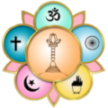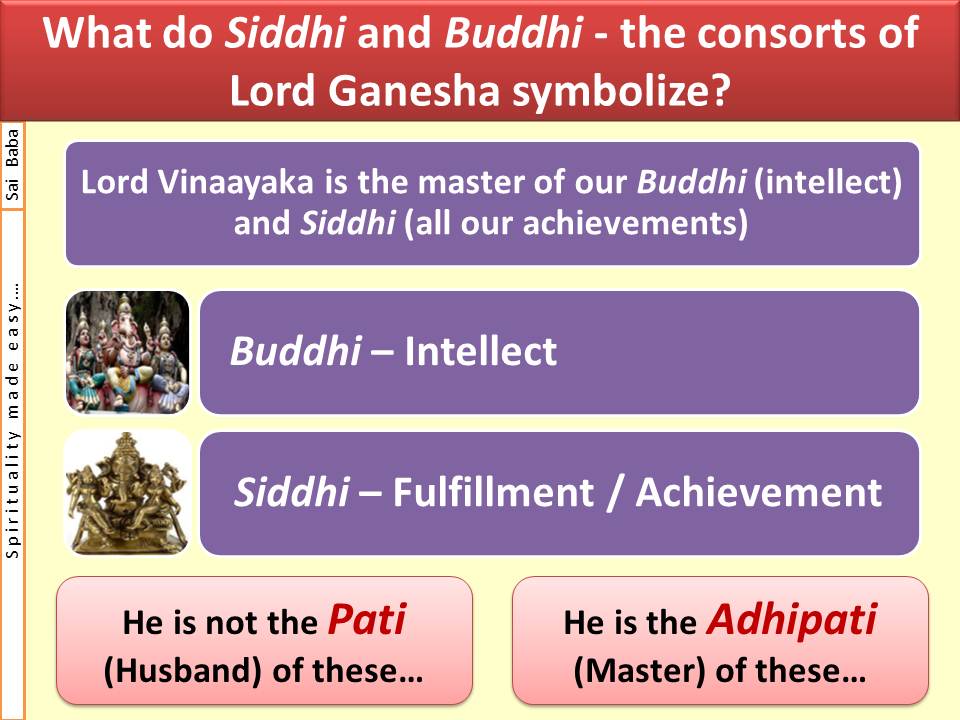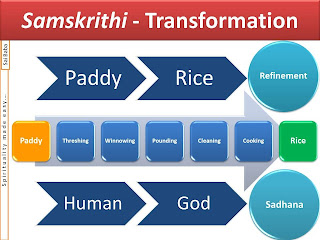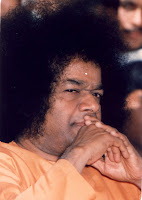This section of the blog presents a message of Bhagawan Baba every week. Mostly, it is the form of a question that is answered by Bhagawan, giving us the correct understanding and interpretation of a concept or a term or a practice. So watch out every Sunday for a special message from Bhagawan Baba that could serve as your driving force throughout the week. Wish you a happy week!!
We have started the MBA programme in our College. When asked what MBA stands for, students say, “Master of Business Administration”. No, no, no… M B A – M stands for Mind, B stands for Body, and A stands for Atma. Therefore, MBA is the collective form of the Mind, Body and Atma.
25 August to 31 August 2014
 |
| Ganesha broke away his tusk to write the Mahabharata!! |
Embodiments of the Divine Atma! This is the most significant teaching of Vighneshwara. His very life is an ideal life, a life full of sacrifice. When we enquire correctly into the scriptures, we may at times neglect the same as mere mythology (myth). It is fine even if we neglect the Puranas (mythology), but we must not neglect the ideals placed before us in these Puranas.
25 August to 31 August 2014
Today, in our human world, we refer to Ganapati as the son of Parvati. Parvati means Prakruti or Nature. The Divine principle, Divine power of Prakruti and Paramatma (Nature and Supreme Godhead) is humanity. Therefore, every human being is Vinaayaka. He is a spark / a drop of the Shiva Shakti Swaroopa (embodiment of Nature and Supreme Godhead) that represents the Divine principle.
18 August to 24 August 2014
| Maanavaananda x 1020 = Brahmaananda |
In the Aananda Valli, the concept of Brahmaanandahas been described in a very unique manner. Brahmaananda is that which cannot be described by humans. It is the one that confers limitless bliss. This bliss cannot be described in words or comprehended by the mind. Unless one leads a calm, stable, peaceful, unsullied and detached day-to-day life, one can never understand this Brahmaananda. In this creation of nature with worldly life and worldly feelings, Brahmaananda has no relevance.
11 August to 17 August 2014
Who is the owner (of the building of creation)? Paramatma (Cosmic Self/God) Himself! When you become one related to Paramatma (God), then you will be able to understand all these valuable principles. Therefore, you need to develop friendship with the owner. How do we develop this friendship? This has been explained in Vedanta clearly, but to make the children understand, I am bringing it down to their level and explaining it in simple terms.
04 August to 10 August 2014
When either anger, jealousy, hatred or any other wicked quality arises in you, suppress it immediately. Tell yourself, “Chhee (an expression of disgust)…this beastial instinct must not exist in me”.
28 July to 03 August 2014
We are forgetting our true form today. We are feeling miserable looking at our temporary form, which is a mere reflection. This is not our true form. We must correctly recognize the Divine principle that is our native land (Svasthaanam– true source). Our native land is the land of the Atman. Adi + Atma = Adhyaatma (spirituality). We must reach our native land (true source); that is spirituality. Only then, will we acquire total happiness.
21 July to 27 July 2014
Vishnu…who is Vishnu? Lord Vishnu is the one who has the Shankha (conch), Chakra (discus), Gadha (maze) and Padma(lotus) in His four hands. In one hand, He has the conch, in another hand, He has the discus, in yet another hand, He has the maze and in the fourth hand, He holds the Lotus. What is the inner significance of these? Conch stands for sound. It means that sound is in the Hands of God. Discuss or wheel is the wheel of time. Time is also in the Hands of God. Maze stands for strength or power. Power is in the hands of God. The Lotus stands for the lotus of the heart. Everybody’s heart is in the Hands of God. Therefore, it is propagated to the world that Lord Vishnu is the all powerful one, bearing symbolically the conch, discus, maze and the lotus.
In the hands of Vishnu, we see the conch and the discus; the maze and the lotus; symbolizing sound, time, power and heart. All these four are in the Hands of God. Coming to Iswara, we find the Damaroo (drum) in His one Hand. In the other Hand, we find the Trishul(trident). The drum represents sound, which means sound is in the Hands of God. The trident represents the subtle form of the three time frames (past, present and future). Therefore, time also is in the Hands of God. Thus, if we see from this perspective, God is only one; the forms and the names are different.
From the worldly perspective, based on the daily experience of the Bharatiyas, here is a good example. The Vasihnavites visit Tirupati (temple). The Shavites also visit Tirupati. But the Lord Venkataramana is only one. When the Shaivites visit Tirupati, they call the Lord as Venkateswara, Venkateswara. When Vaishnavites visit Tirupati, they call the Lord as Venkataramana, Venkataramana. One one hand “Iswara” and on the other hand “Ramana”. The difference lies only in the feelings (of the devotees) but there is no change in Lord Venkateswara. It is only for the satisfaction of the narrow minded people that the Lord is referred to as Venkataramana and Venkateswara.
Iswara is known as Pasupathi. Pasupathi means the Lord of all the pasus, i.e. the animals (cows). What is the meaning of Pasu? The life principle that combines the mind and the intellect is referred to as an animal. With respect to Lord Vishnu, they call Him Gopala. Gopala and Pasupathi actually mean the same. Some call Him Gopala while the others call Him Pasupathi. Even the name points out and highlights the principle of unity. But, it is the narrow mind of the humans that is the root cause for all diversity. However long we may perform Sadhana (spiritual practice) with this narrow mind, we would never be able to reach noble heights. We must recognize unity in diversity. That is true spirituality. You are God. Until you do not realize this, you are Jeeva(individual being); once you realize and know this, you are Daivam (God).
14 July to 20 July 2014
In temples of Iswara (Lord Shiva), there is always a Nandi (bull) at the front. If we enquire as to what this bull stands for, the temple authorities as per their traditions would state that the bull is the vehicle (vahana) of Lord Iswara. But, is it that Lord Iswara could not get a better vehicle than the bull? Why should He have the bull specifically? Therefore, it is very wrong to consider the bull as the vehicle of Lord Iswara.
07 July to 13 July 2014
30 June to 06 July 2014
Here’s a small example. In ancient times, people performed Yajnas(sacrifices) and Yaagas (religious rituals). The scriptures have clearly stipulated the procedures for all the Yaagas and Yagnas. But there were none to uncover and clearly explain the inner significance of these rituals. They spent all their life only in external activities.
23 June to 29 June 2014
Be it great men or scholars, they are unable to communicate the message of spirituality to the youth of today, in a meaningful manner, explaining the inner significance in a way that it gets imprinted in their hearts. They presume that spirituality is mere acts of nobility like worshipping, doing Bhajans, going on pilgrimages, visiting temples, etc. The main cause for this is that they themselves have not understood and recognized the truth in the Vedas and the Vedangas (auxiliary disciplines of the Vedas), the inner significance in the Itihaasa(scriptures) and Puranaas (epics) and the true meaning of this world (Jagath).
16 June to 22 June 2014
In the morning, Dr. Venkataraman, while explaining the principle of spirituality, stated that God, after creating this universe, did not retain it within His control, but gave away all His powers to mankind. This is true. God is the creator. He created everything. But God who created this (world) did not retain its power in His hands. He gave away all the powers to the people. But along with all the powers that He bestowed on mankind, He just laid down one condition.
09 June to 15 June 2014
Students! You are all youth. There is so much energy contained in youth. The power that is present in this earth is present in you too. The attraction power, the radiance, the current is very much in you. When all the powers are present in you; to lead a life as though you have no power at all, is such a weakness. Wherever there are difficulties in the country, you must go running there and participate in serving there. You must not give any scope for differences like “who are they and who am I?” Give up all the differences of “theirs” and “mine”. Have the feeling that everything is mine! Recognizing the oneness in diversity, you must participate in service to the society.
02 June to 08 June 2014
Man has been bestowed with the intellect (Buddhi) so as to know his true Self. The intellect is highly sacred and pure. The mirror of the intellect is coated with the chemical of Love on the reverse side (just like in a mirror, the glass is coated with a reflective substance like non-toxic silver or sputtering aluminium). If the reflective chemical is not coated on the reverse of the mirror (glass), we would not be able to see our reflection in it. That is why the chemical of Love is coated on the reverse side of the mirror of intellect. Today we are looking through the intellect that does not have the coating of Love. That is why we are seeing the objects that are behind the mirror of the intellect, but are not able to see the object that is in front of it.
26 May to 01 June 2014
God can be known by so many names, indeed thousands of names. But among all names, the most apt and significant name is Sath–Chit–Ananda (Sathchidananda). Sath means eternal (Truth), Chit means total (Awareness). The unity of the two is Ananda (Bliss). Sath is like sugar, Chit is like water, when we mix the two it becomes sugar syrup. The sugar syrup is like Ananda. If, however, we keep sugar separate and water separate, how can we get sugar syrup (Ananda)?
19 May to 25 May 2014
Embodiments of love! You are full of bliss and happiness. Forgetting your own true form of bliss and happiness, you are struggling in this world for bliss and happiness. Being the very embodiment of bliss, it is so ignorant to search for bliss in this world. When we wish to acquire this bliss, the five sheaths place all sorts of obstacles in our way. These are called the Klesha(afflictions).
12 May to 18 May 2014
Once upon a time Buddha set out to seek alms. He neared the village that he was supposed to go to. All the residents of that village had great faith in Buddha. However, as he reached close to the village, some rowdies (ruffians), taking to the wrong path, started abusing him in all ways. Instead of travelling further, Buddha sat there on a rock. He asked (the ruffians), “Children, what is the pleasure that you get in abusing me?” Not giving any reply to him, they started abusing him in a more heinous manner. Buddha sat there stating that they could abuse him as long as they wanted.
05 May to 11 May 2014
Though the same Atman is in all, based upon the ego and attachment of each human body, every individual takes upon the respective joys and sorrows. Here is a small example. Let us say there has been a plane accident somewhere. If our own relatives were to be on that plane, one need not express what our state would be. We would put in efforts for making all types of enquiries. However, if our own people are not on that plane then we get into all sort of gossip, “how did the crash take place?”, “what did happen actually?”, “how many have died?”, etc. We thus get into the act of collecting information.
28 April to 04 May 2014
It is very difficult to understand the principle of Chaitanya. Chaitanya is referred to as consciousness. In order to recognize and understand the principle of consciousness, we take a small aspect of it called the “Conscience”. Conscience means the witness. It is also called Awareness. From this conscience, further comes the “Conscious”.


































.jpg)















